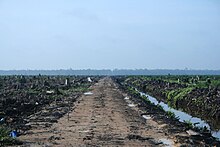


Deforestation or forest clearance is the removal and destruction of a forest or stand of trees from land that is then converted to non-forest use.[1] Deforestation can involve conversion of forest land to farms, ranches, or urban use. About 31% of Earth's land surface is covered by forests at present.[2] This is one-third less than the forest cover before the expansion of agriculture, with half of that loss occurring in the last century.[3] Between 15 million to 18 million hectares of forest, an area the size of Bangladesh, are destroyed every year. On average 2,400 trees are cut down each minute.[4] Estimates vary widely as to the extent of deforestation in the tropics.[5][6] In 2019, nearly a third of the overall tree cover loss, or 3.8 million hectares, occurred within humid tropical primary forests. These are areas of mature rainforest that are especially important for biodiversity and carbon storage.[7][8]
The direct cause of most deforestation is agriculture by far.[9] More than 80% of deforestation was attributed to agriculture in 2018.[10] Forests are being converted to plantations for coffee, palm oil, rubber and various other popular products.[11] Livestock grazing also drives deforestation. Further drivers are the wood industry (logging), urbanization and mining. The effects of climate change are another cause via the increased risk of wildfires (see deforestation and climate change).
Deforestation results in habitat destruction which in turn leads to biodiversity loss. Deforestation also leads to extinction of animals and plants, changes to the local climate, and displacement of indigenous people who live in forests. Deforested regions often also suffer from other environmental problems such as desertification and soil erosion.
Another problem is that deforestation reduces the uptake of carbon dioxide (carbon sequestration) from the atmosphere. This reduces the potential of forests to assist with climate change mitigation. The role of forests in capturing and storing carbon and mitigating climate change is also important for the agricultural sector.[12] The reason for this linkage is because the effects of climate change on agriculture pose new risks to global food systems.[12]
Since 1990, it is estimated that some 420 million hectares of forest have been lost through conversion to other land uses, although the rate of deforestation has decreased over the past three decades. Between 2015 and 2020, the rate of deforestation was estimated at 10 million hectares per year, down from 16 million hectares per year in the 1990s. The area of primary forest worldwide has decreased by over 80 million hectares since 1990. More than 100 million hectares of forests are adversely affected by forest fires, pests, diseases, invasive species, drought and adverse weather events.[13]
- ^ SAFnet Dictionary|Definition For [deforestation] Archived 25 July 2011 at the Wayback Machine. Dictionary of forestry.org (29 July 2008). Retrieved 15 May 2011.
- ^ Deforestation|Threats|WWF. Worldwildlife.org. Retrieved 13 November 2016.
- ^ Ritchie, Hannah; Roser, Max (9 February 2021). "Forests and Deforestation". Our World in Data.
- ^ "On Water". European Investment Bank. Retrieved 13 October 2020.
- ^ Cite error: The named reference
:0was invoked but never defined (see the help page). - ^ Cite error: The named reference
:1was invoked but never defined (see the help page). - ^ Cite error: The named reference
Guy-2020was invoked but never defined (see the help page). - ^ Cite error: The named reference
:2was invoked but never defined (see the help page). - ^ Cite error: The named reference
UNFCC-2007was invoked but never defined (see the help page). - ^ Cite error: The named reference
ScienceDaily-2018was invoked but never defined (see the help page). - ^ Cite error: The named reference
WWF-2020was invoked but never defined (see the help page). - ^ a b The State of the World's Forests 2020. Forests, biodiversity and people – In brief. Rome: FAO & UNEP. 2020. doi:10.4060/ca8985en. ISBN 978-92-5-132707-4. S2CID 241416114.
- ^ The State of the World's Forests 2020. In brief – Forests, biodiversity and people. Rome: FAO & UNEP. pp. 9–10. ISBN 978-92-5-132707-4.